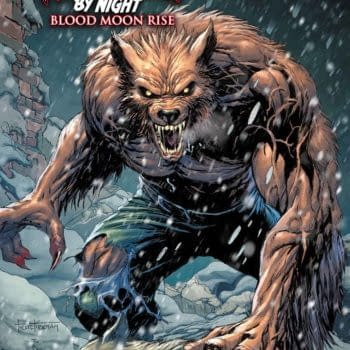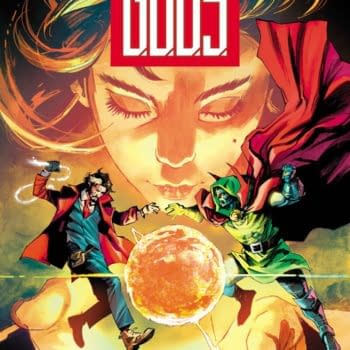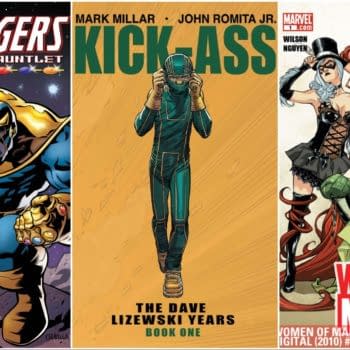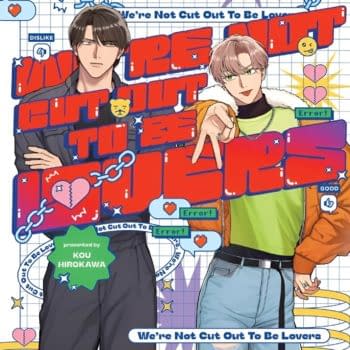Posted in: Comics | Tagged:
Creative Artists Discuss The Impact Of Wonder Woman Movie On Pop Culture At Wizard World Sacramento 2017
By Hilton Collins
Great Hera! June's been a banner month for Warner Bros. when it comes to the reputation of their DCEU film slate. Wonder Woman, the latest DC movie, is a critical and financial hit. The ginormous box office totals and a boatload of positive reviews prove it.
And you could say it's arguably what the DCEU needed. Although Man of Steel, Batman v. Superman, and Suicide Squad did well financially, they were divisive with audiences most critics hated them (especially Batman v. Superman and Suicide Squad), so a lot of viewers had lost faith in the DC movie brand.
But then came Wonder Woman, which is not only successful but also possibly a cultural touchstone for female representation in action movies. On Saturday, June 17, five panelists discussed the movie's quality and impact in an afternoon session at Wizard World Sacramento inside the Sacramento Convention Center. Tony B. Kim, the man behind the Crazy 4 Comic Con blog and Hero Within fashion business, moderated a podcast with writers Genese Davis (Holder's Dominion) and Victor Dandridge (Vantage: Inhouse Productions), artist Trina Robbins (Wonder Woman comics), and cosplayer Ivy Doomkitty. He questioned them about their thoughts on Wonder Woman's impact.
The panelists dissected the movie mostly chronologically, almost scene-by-scene.
So of course, the segment about the early Themyscira scenes was the first one to evoke healthy discourse.
Robbins and Dandridge felt that Themyscira's live-action depiction was perfectly realized. Though Robbins has drawn Wonder Woman comics and has been a fan of the character for decades, she'd never known what the superheroine's island homeland would look like on screen until the movie showed her.
Watching the movie was an emotional experience for many women, including Robbins. They don't often see themselves portrayed so powerfully.
"What is incredible to me is how many women have been watching this movie and weeping," she said, addressing the audience. "If you guys are in the audience, you probably do get it but there's a lot of guys who don't get it. And I just have to tell them, 'I'm sorry. I'm sure you're a nice person, but you don't get it. You don't understand why the women are crying.'"
Davis and Doomkitty loved seeing the Amazons charge into battle against the Germans with authority. They took a proactive role that's uncharacteristic for women in movies, and Wonder Woman had multiple female characters who embodies this; not just the main star.
"It was so validating and exciting to see the screen full of these amazing confident fighting women. It was awesome," Davis said.
Kim commented that, normally in movies like this, the women take more passive roles, like picking fruit or selling items in markets. Doomkitty was overwhelmed by the Amazons' toughness and agency.
Wonder Woman herself, whose real name is Diana, was the princess of Themyscira, but she didn't want to remain protected or coddled forever, which is why she chose to leave her homeland to come with Steve Trevor to fight in World War I. Her mother Hippolyta, the Amazon queen, wanted to keep her shielded and secluded from the outside world's dangers earlier in the film. Doomkitty liked Diana's insistence that she take charge of her own life and assume a more active role. However Davis, who's a mother to a two-year-old daughter, sympathized with Hippolyta's motive.
Dandridge was the one panelist who disliked the movie based on its storytelling decisions. One problem for him was the absence of Greek goddesses in the movie, a contrast to their prominent role in the Amazons' lives in DC Comics stories. On the other hand, Robbins enjoyed the movie immensely, but she agreed that that the Greek goddesses' absence was troublesome.
In the 1940s, Wonder Woman's original writer William Moulton Marston made the goddesses responsible for the Amazons', and Wonder Woman's creation. Hippolyta sculpted a baby girl named Diana from clay, and goddesses used mystical power to bring Diana to life. The goddesses also created the entire Amazon race. The movie changed the origin considerably, however, by making Zeus, the king of the gods, the deity who created the Amazons. He also got Hippolyta pregnant, which is how Diana was conceived. These were drastic departures from the classic comic book origin.
"William Moulton Marston's origin is mythic," Robbins said. "[In many myths] the hero, male or female, is always the offspring of a virginal mother and a deity. In this case, the virginal mother is Hippolyta, queen of the Amazons. The deity is Aphrodite, who breathes life into this clay statue that Hippolyta has been instructed to make. Athena shows her how to make the statue. [It's] completely feminist; there's no man involved at all."
Panelists liked the portrayal of Steve Trevor, Wonder Woman's most well-known love interest. Davis, specifically, felt that he never came off entitled or arrogant, and his noble self sacrifice at the movie's end cemented his loyalty and bravery as a person. He was also at the center of an interesting role-reversal: whereas female characters are usually surprised and objectified while nude in films; this time, Steve the male character was the one who was surprised and objectified while he bathed on Themyscira.
Steve was the first man Diana had met, but she meets more men later when she joins him to travel to London to fight in the war. The movie highlighted the sexism women face in male-dominated environments, especially in the early 1900s. When Diana follows Steve into a planning session where male generals discuss tactics and intelligence, they immediately assume she's a secretary, not a warrior, and they want to dismiss her outright because she's not a man. This doesn't stop her from arguing with a general and pressing her own point of view, however. Davis could relate to Diana's situation. The author writes film novelizations for Benaroya Pictures, and she goes to meetings that are dominated with male executives, and she's the only female voice in the room.
Diana quickly proves herself as an asset, however, and not just physically. She knows many languages and must interpret ancient Sumerian for Western soldiers, and more famously, she uses her powers to cross heavy machine gun fire over dangerous terrain called No Man's Land in what's arguably the movie's most iconic sequence.
"The beauty of it being No Man's Land but it's crossed by a woman," Dandridge said. "You can't escape that truth that that's a beautiful moment."
He felt that the World War I setting was great for a few reasons. For one thing, it distanced Wonder Woman from seeming like a Captain America clone. In comics, both characters actually debuted in the 1940s during World War II, Wonder Woman for DC and Captain America for Marvel. But Captain America's origin movie already came out in 2011, where the film had him in the second war, so if Wonder Woman had done the same thing, it would've looked like a copy.
Secondly, World War I was the dawn of the modern warfare, with killing machines and chemicals that destroyed life on a massive scale. Wonder Woman would witness a new level of horror and carnage, awakening her to how dark the world actually was. Her hopefulness and stern resolve would be a stark contrast to the bleakness.
But Wonder Woman wasn't all fighting–Diana and Steve had a very tasteful love scene, almost. During some much-needed evening downtime, the two of them head upstairs to a private room and kiss before the scene fades to black. On the next cut, they're outside in the morning, and the intercourse that transpired between night and day has been left to the audience's imagination.
At first, Doomkitty was worried when she could tell Diana and Steve were going to have sex. She was concerned it could've been exploitative and detract from Wonder Woman's more substantive aspects. Fortunately, Patty Jenkins, the director, and screenwriter Allan Heinberg handled the situation tastefully.
"I appreciated the fade-to-back," Doomkitty said. "You know what was going to happen, and that was it. It maintained the integrity of the character."
In one case though, Wonder Woman herself maybe had a little too much integrity–Davis noticed that the Amazon hero basically looked perfect all the time, which reinforced impossibly high beauty standards in women. Wonder Woman burst through buildings, stabbed people, and charged through dirty battlefields, but she never got dirty or cut, and no blood ever spattered on her. She was beautiful and pristine throughout, and Davis felt it was ridiculous.
"I wish they could have allowed Wonder Woman to have a spec of rubble on her shoulder or a smear across her cheek or a splash of blood," Davis said.
Most panelists were surprised when Sir Patrick Morgan turned out to be Ares, the main villain, in disguise. The three villains overall–Ares, Dr. Poison, and Gen. Ludendorff–were intriguing to most of the panel, but still a bit underwritten.
"I think movies are still struggling with that aspect, [the] mustache-twirling villain," Davis said. "It was a distraction from the film instead of a real enhancement. They could've pushed the villains more in-depth."
The panel ended with everyone rating the movie on a scale of one to ten. From highest to lowest, the rankings were: Robbins, 9 3.4; Doomkitty, 9; Kim, 9; Davis, 8.5; and Dandridge, 5
















